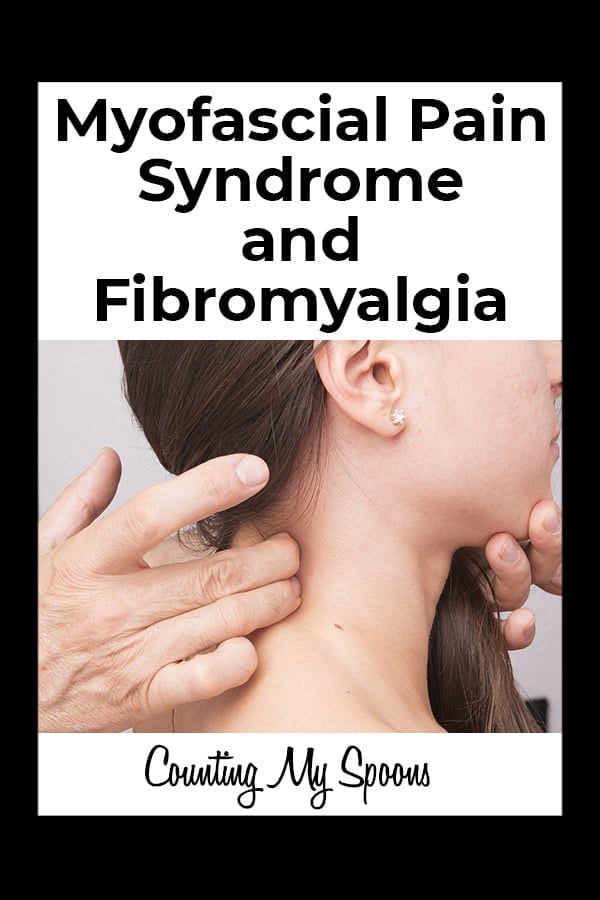Myofascial pain feels a lot like muscle pain, chances are you may not be able to tell the difference. But, there is a difference. Myofascial pain isn’t caused by tight muscles, but rather by tight fascia. Fascia is the layer of tissue just underneath the skin, between the skin and the muscles/organs. Fascia covers the entire body and is a primary connective tissue that connects and protects your muscles and organs. The appearance of fascia is similar to cotton candy as the threads of fascia wrap around every muscle and organ in the body.
Fascia can become tightened over time due to injuries or just from a lack of stretching. When the fascia becomes overly tightened it puts pressure on the muscles, joints, and organs. That pressure causes pain.

What’s the difference between myofascial pain syndrome and fibromyalgia?
There is a lot of overlap between fibromyalgia and myofascial pain. Some consider myofascial pain syndrome to be a subset of fibromyalgia. While myofascial pain syndrome involves primarily localized muscle pain, fibromyalgia involves pain throughout the body as well as generalized fatigue and other symptoms.
Additionally, while myofascial pain is caused by tightness in the fascia itself, research has shown that fibromyalgia is likely a neurological disorder in the way that we process pain, rather than an actual issue in the tissues themselves.
Tightness in the fascia can cause pain throughout the body through referred pain. If the fascia in your leg is tight, you’ll likely favor the other leg and walk unevenly which can lead to referred pain throughout the body as your skeletal system is thrown off balance.
I first learned about myofascial pain years ago, when I was in physical therapy for neck and head pain (prior to finding out the problem was TMJ). I had one therapist who seemed to understand what I was dealing with and would massage my head in such a way that it helped release that tension and make me feel better.
What causes myofascial pain syndrome?
Much like fibromyalgia, myofascial pain syndrome is usually triggered by an injury or trauma of some sort. It may be a car accident, or an on-going issue (TMJ was the culprit for me – or perhaps myofascial pain syndrome is just a symptom of TMJ?). Myofascial pain syndrome can also be caused by repetitive motion injuries, or muscle strain or sprain.
What is the best way to treat myofascial pain?
While you can ease myofascial pain at home, with physical therapy, or trigger point injections. I’ve found it’s best treated with myofascial release therapy. This is a specific type of therapy similar to a deep tissue massage, but done very specifically to release the tension in the fascia.
Often you will find massage or physical therapists that incorporate some myofascial release therapy into their massage. If you are lucky you will find a myofascial release therapy practitioner that focuses solely on this type of therapy.
It wasn’t until after I was diagnosed with fibromyalgia and went through PT for that, that I had someone really explain myofascial pain and myofascial release to me in a way that helped me understand it.
My therapist showed me how to do myofasical release to my arms and legs. Doing myofascial release looks almost like you are giving yourself (or whoever you are doing it to) an Indian burn. Grabbing with both hands and rubbing deeply in opposite directions to stretch the tissue just below the skin.
It sounds strange and uncomfortable, yet even as the therapist was doing it to me, I realized it was something I often did to myself without even realizing it. It just made me realize that so often we know what our bodies need, just by instinct and we will attempt to do the motions, or movements that will make us feel better. Sometimes we just don’t quite know how to do it correctly.
Later, I found someone who focuses strictly on myofascial release therapy. Their approach was a bit different. They were gentler, which was good given that they’d treat me for an our with just myofascial release.
If you deal with this type of pain, you may want to seek out a physical therapist or a massage therapist that understands the techniques behind myofascial release and see if it helps you. If you have a good physical therapist they will be happy to show someone who loves you how to do the technique, and even show you how you can do it to yourself to ease your pains.
Related Posts:


Denise says
Thanks for sharing this much-needed information. I had a cervical fusion and struggled with what I thought of as trigger point pain, but it would not go away. One of my physical therapists mentioned myofascial pain syndrome. I found a specialized therapist, the only one trained in my state that could treat this condition. I have AS and other conditions and it is not easy to deal with chronic pain. Take care!
Julie says
I’m glad you found someone nearby. I miss my MFR guy. Do you follow a low-carb diet for the AS?